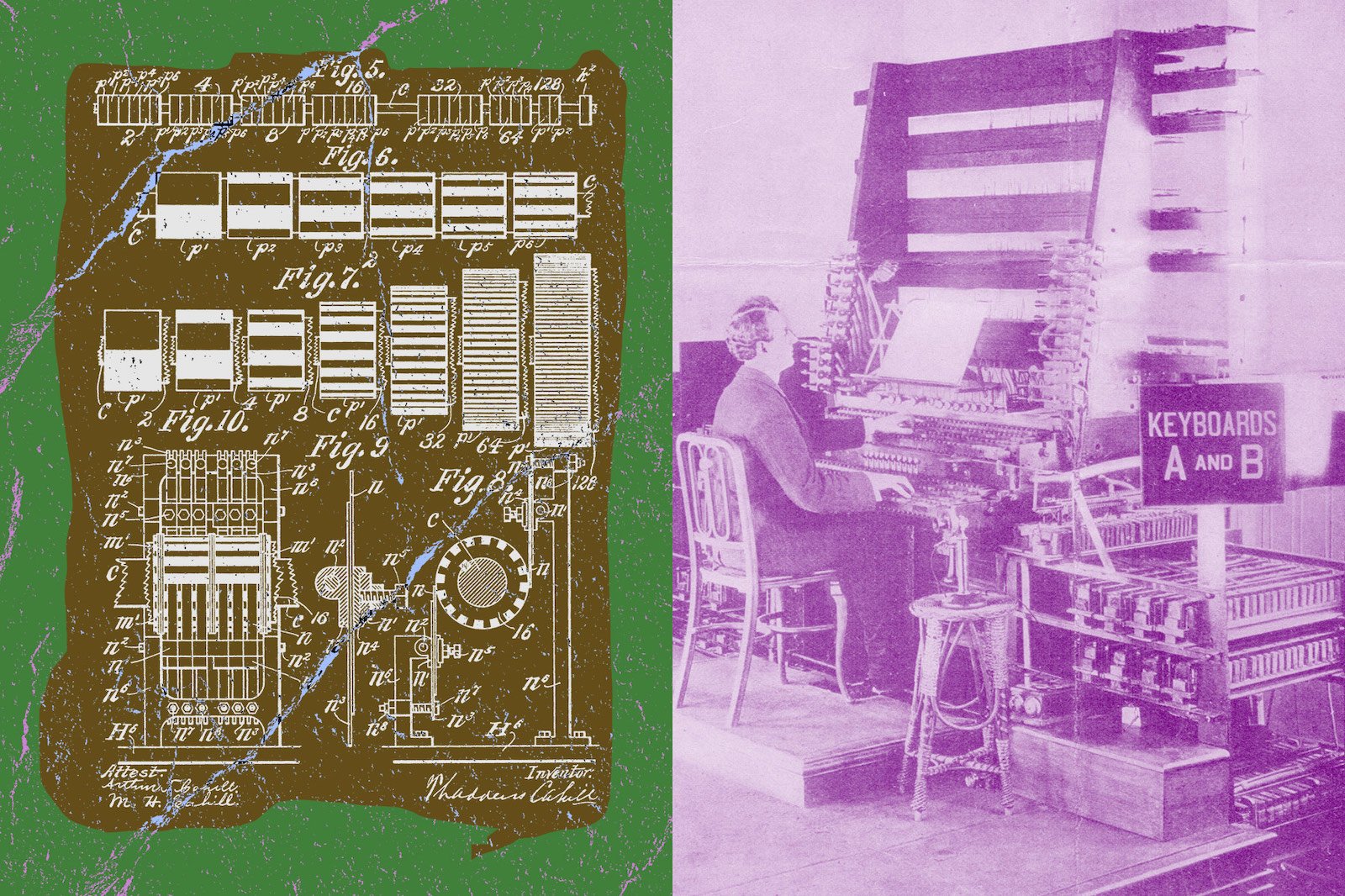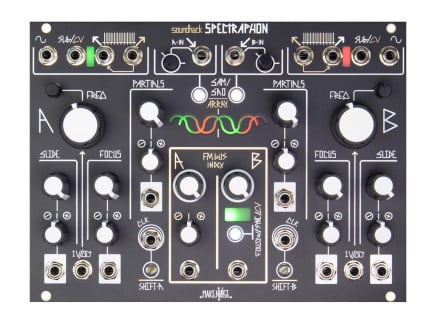When many of us think of earliest synthesizers, we usually think of the 1960s and the rise of modular synthesis. Or perhaps you might think of the RCA MkII in the 1950s, as discussed in another recent article. Maybe we reach back to the rise of the theremin in the 1920s. But one of the earliest electronic instruments existed just before the turn of the 20th century—well before the proliferation of the term “synthesizer.”
In 1895 Thaddeus Cahill submitted the design for US Patent No. 580.035, under the name “The Art of and Apparatus for Generating and Distributing Music Electrically.” Although the patent was rejected at first due to the patent office’s view that the “plan contained principles and practices found in other patented devices,” Cahill was not discouraged; his experience as a lawyer helped the patent to be accepted in 1897. Over the following decades, Cahill sought to refine his idea of a perfect instrument. He wanted to overcome what he saw as the limitations of musical instruments that existed at the time. Cahill considered his invention a universally pure musical instrument. It was capable of synthesizing a wide range of sounds with mechanical precision.
In its time, the device would be known as both the Dynamamaphone and the Telharmonium—the term "Telharmonium" referring to the melding of "telegraphic" and "harmony." This refers to the fact that concerts were transmitted over telegraph lines, a novel concept at the turn of the century. Three versions of the Telharmonium were constructed between 1897 and 1914, at which point Cahill was forced to file for bankruptcy.
Origins of the Telharmonium
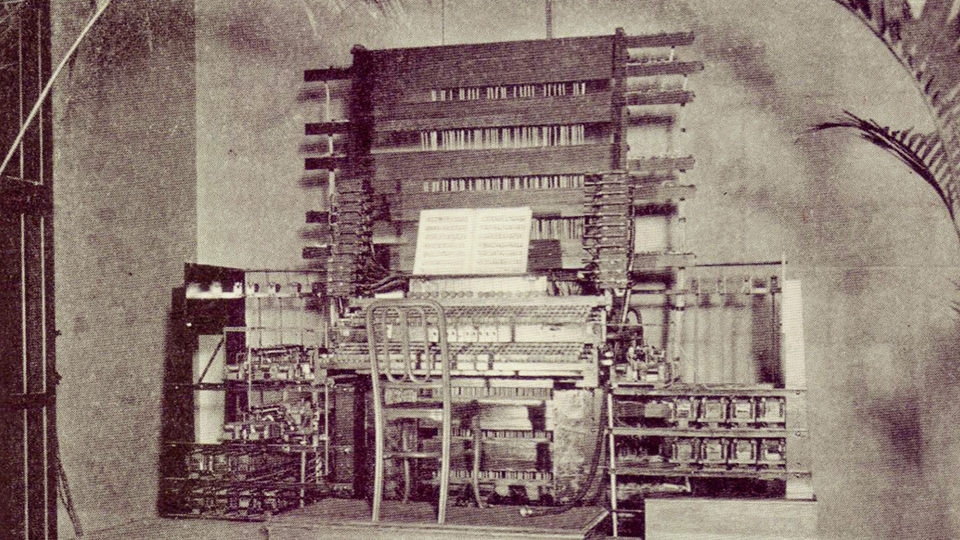
[Above: an image of the Telharmonium's playing interface/console.]
Cahill was influenced by German scientist Hermann von Helmholtz’s 1862 book On The Sensations Of Tone, which was translated into English in 1877. In it, Helmholtz proposed that music and sound were made up of harmonics, which caused the differences in timbre between musical instruments, even when they played the same note. Obviously, another influence was Joseph Fourier’s work on the sinusoidal nature of sound. Namely, any periodic sound can be represented by a series of sine waves of varying pitches, amplitudes, and phase relationships. This led to our understanding of the harmonic series, where overtones of a sound are multiplications in frequency with a corresponding reduction in amplitude. A sine wave only includes the fundamental frequency and no corresponding harmonics; a sawtooth waveform includes all harmonics, while a square wave only includes the odd harmonics.
Music over telegraph lines was not an entirely new phenomenon, though. In 1809, Prussian scientist and inventor Samuel Thomas Soemmerring laid out an experiment on human consciousness and perception. He constructed a telegraphic system where a collection of tuned bells were triggered remotely from several kilometers away via telegraph. While intended to measure perception, it opened the doors to telegraphic music that would influence Cahil. Parisian inventor Clément Ader created the "Théâtrophone" in 1881 to broadcast music and theater over telegraph lines until the widespread proliferation of radio, while in 1890s London, the Electrophone provided a similar service.
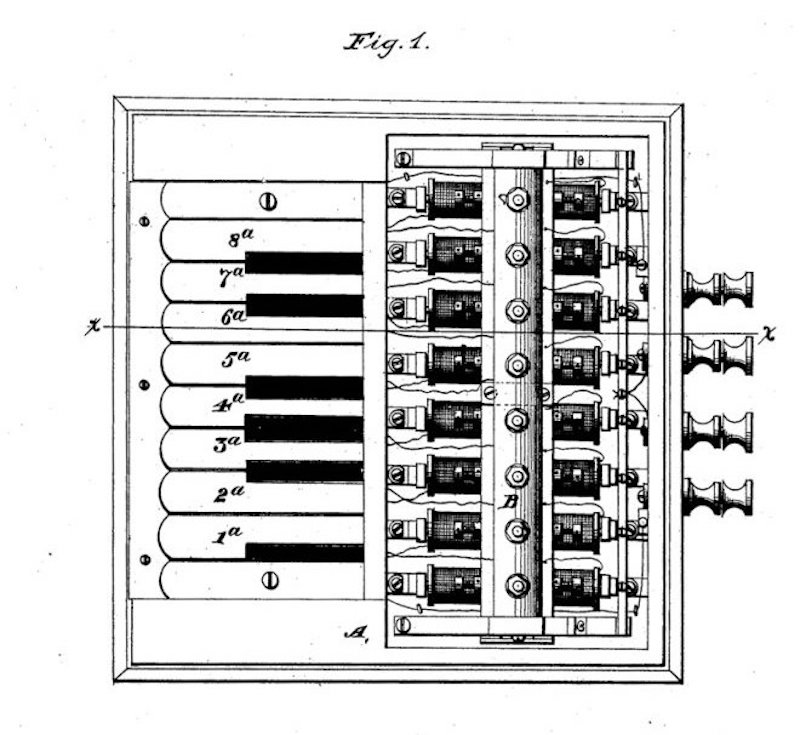 A digram from Elisha Gray's 1876 patent application for the Musical Telegraph
A digram from Elisha Gray's 1876 patent application for the Musical Telegraph
However, the most similar idea of the time was Elisha Gray’s Musical Telegraph. Gray, an early inventor of telephone technology, created a device that used electro-magnetically controlled vibrating metal reeds to send pitched tones over telegraph lines. He even included a musical keyboard to play the invention. The idea was an early attempt at sending multiple signals over a single network, which would be implemented with multiplexing. Cahill regarded the device with derision, describing the resulting sounds as “poor, harsh tones” that were “sharp [and] violent.” The similarities between the Telharmonium and the Musical Telegraph were part of the reason Cahil’s patent was originally rejected. One of the biggest drawbacks of the Musical Telegraph was its lack of power. It could only be heard at extremely close ranges to the telephone receiver. The other was the static nature of the sounds—with no control over their timbre. Cahill sought to improve on the power and musicality of the early predecessor.
He set his sights on replacing acoustic instruments of all kinds. He wanted the expressiveness of a violin, the sustain of an organ, and the responsiveness of a piano, all with the polyphony and intensity of an orchestra. Many musicians and listeners disagreed with Cahill that the imperfect nature of traditional musical instruments was something to be overcome; but rather, those imperfections were what made them compelling to listen to.
The Telharmonium offered an early example of what we now call additive synthesis. It used a combination of tone wheels and electro-magnets to generate sounds. Several giant cogs of varying sizes were lined up next to an electromagnetic receiver to move electrons in sinusoidal waves. Where the teeth of the cogs lined up with the electro-magnet, it would move the electrons in one direction, and when the spaces between the cogs lined up, they would return to their initial position.
 An illustration of the Telharmonium's tonewheel-like dynamos, complete with multiple patterns for producing a fundamental frequency and multiple higher partials.
An illustration of the Telharmonium's tonewheel-like dynamos, complete with multiple patterns for producing a fundamental frequency and multiple higher partials.
Each note corresponded to an individual dynamo with a fundamental frequency and six partials. While a single cog would produce a harmonically pure sine wave tone, stacking multiple cogs adds additional higher harmonics to this simple and pure tone. As harmonics increase in frequency, they decrease in amplitude. The addition of timbre-shaping capabilities on the Telharmonium was one of the biggest advancements in technology. At this point in time, there had been some electronic-based sound generators, but they typically only produced a single sound with no control over its timbre. The size of the cogs and the speed that they rotated determined the audible pitch. The sound of the tonewheels on their own, particularly in the early versions of the Telharmonium, was harsh, so additional induction coils were added to "smooth" the sound.
The Telharmonium was a polyphonic instrument, meaning that a user could play more than one note at a time. In fact, the Telharmonium had not just one keyboard, but a series of keyboards meant to be played in unison. Most often, it would not be played by a single musician but by a pair of them controlling both the pitches (bass lines and melodic top lines) and timbre of the music. In addition to the keyboards, the Telharmonium included organ-style stops to control its timbre. The Telharmonium included two sets of tuning systems—an arrangement of the harmonic series to build timbre, and an equal-tempered scale for combining and playing compositions.
In addition to having two tuning systems, the MkII Telharmonium boasted a complex player interface. For the second iteration of the Telharmonium, Cahill worked with Pianist Edwin Hall Pierce to design the keyboard system. Instead of a standard singular piano keyboard, it included multiple keyboards with alternating black and white keys that divided the octave into 36 keys.
The size of the Telharmonium was partially due to the fact that amplifiers, as we know them today, didn’t exist at the time. In order to create enough energy to make audible tones, the size of the cogs must be correspondingly large. Concerts were transmitted over telegraph wires that listeners could amplify with a special telephone receiver/amplifier in the shape of an elongated horn. Telephones of the day were not suited to playing music, and the quality left quite a bit to be desired. Unfortunately, it introduced some crosstalk in telephone lines. Sometimes, everyday phone conversations would be interrupted by blasts of esoteric electronic music.
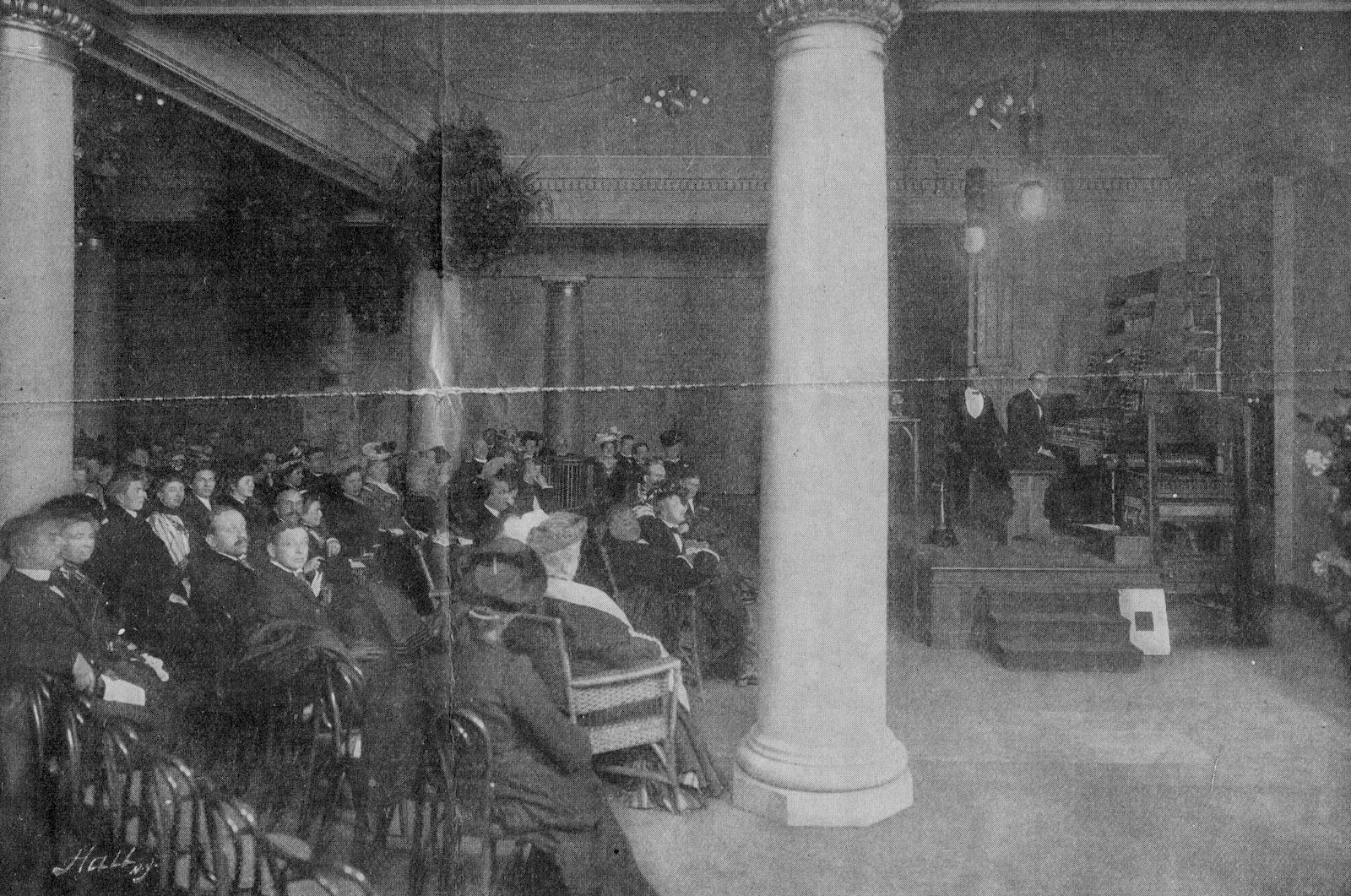
[Above: image of a period performance of the Telharmonium at Telharmonic Hall / Telharmonium Hall.]
Like many examples of early electronic music, some of the motivation behind it was to replace having to pay a group of musicians to create music. Some restaurants and hotels saw it as a way to bypass the need to hire live musicians. They bought specialized acoustic receiver amplifiers in order to hear the music. It predated Muzak by several years but could be seen as an early precursor to that idea.
At an early investor meeting, Cahill put on a demonstration of the technology for a group of businessmen in Baltimore. He broadcasted a performance of Handel’s Largo over a phone line from Washington D.C., to the surprise of the gathered investors. They agreed to put up the first $100,000 for the Telharmonium.
The first version of the Telharmonium was constructed in 1897 as a proof of concept for investors. It was hand-built and weighed 14,000 lbs, small by the standards of its successors. Once enough investors were brought on board, Cahill began work on the MkII in 1902. It was no small feat, requiring a team of fifty workers. It was the size and shape of a power station, weighing over 200 tons and costing $200,000.
While it was built in Holyoke, MA, but disassembled and moved to Telharmonic Hall in New York City in 1906. It resided in a specially designed concert hall on 39th and Broadway, ready to give in-person concerts and broadcast its performances to hotels, restaurants, theaters, and even homes. However, by 1907, things looked dire for the Telharmonium. Interest was waning, and not enough cash was coming in to cover salaries, let alone maintenance costs. Finally, Telharmonium Hall closed its doors in 1910.
The Telharmonium's Untimely End
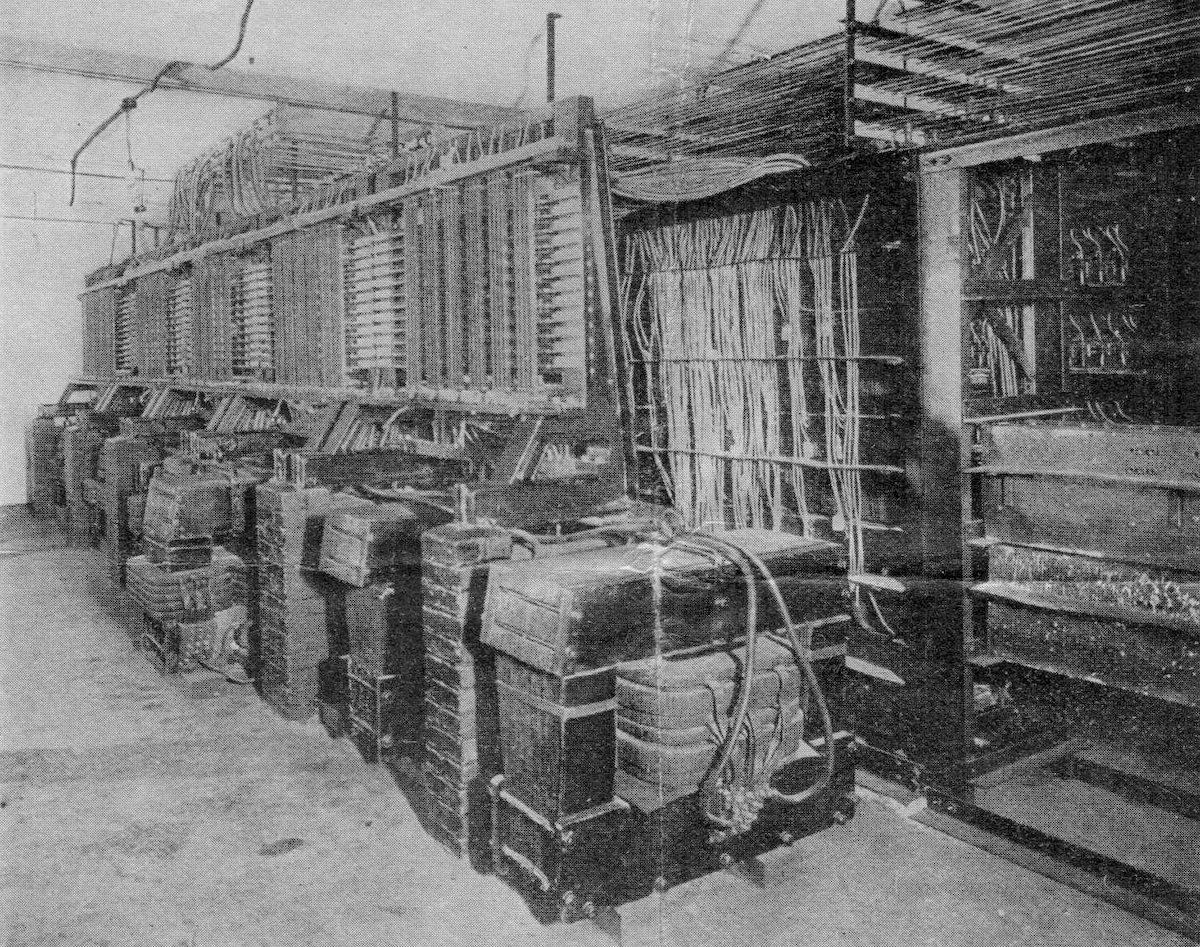
[Above: the intricate, elaborate, and unwieldy inner workings of the Telharmonium.]
Cahill thankfully regained control over the rights to the Telharmonium after the shuttering of its concert hall. He went back to Holyoke and worked on the third and final iteration of the Telharmonium. He improved on the design, adding new features, including new alternators and a more traditional keyboard. In 1912, it made its debut from the basement of a building on 56th Street, broadcasting music to a small concert room in Carnegie Hall. The public’s interest had waned from the original novelty of the Telharmonium. While it had fans, including Mark Twain, overall, technology had progressed past the Telharmonium and its turn-of-the-century charm. By 1914, Cahill had to file for bankruptcy. The MkII and MkIII were sold for scrap. The MkI was preserved by Cahill’s brother, but only until his death in 1958, after which it was scrapped as well.
Approximately $1,000,000 was spent on the various Telharmoniums from 1897–1914, or around $30 million today. Cahill’s plan for a subscription-based service never made it off the ground, and no profit was even seen. Other advancements in technology also rendered the Telharmonium obsolete, including the emergence and proliferation of radio as a medium for broadcasting music and news.
One direct descendent of the Telharmonium was the Hammond organ. By introducing amplifiers into the signal path, the massive, building-size contraption could be miniaturized. The industrial, power plant sized dynamos shrank to compact tone wheels, with a similar effect.
Unfortunately, no recordings of the Telharmonium survive to this day. The hulking machines were sold for scrap to recoup some of the massive investments in this groundbreaking technology. While the sounds were simple and the interface complex, the technological advancement of additive synthesis was groundbreaking. It laid the way for other, more accessible synthesis methods to come over the 20th century and beyond.

